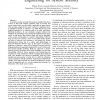1548 search results - page 130 / 310 » Estimating Software Vulnerabilities |
ICC
2007
IEEE
15 years 5 months ago
2007
IEEE
— In modern wireless networks the functions included into layer II have to deal with complex problems, such as security and access control, that were previously demanded to upper...
MSR
2006
ACM
15 years 5 months ago
2006
ACM
Various static analysis tools will analyze a software artifact in order to identify potential defects, such as misused APIs, race conditions and deadlocks, and security vulnerabil...
128
click to vote
CANS
2006
Springer
15 years 3 months ago
2006
Springer
Software watermarking is a new research area that aims at providing copyright protection for commercial software. It minimizes software piracy by hiding copyright signatures inside...
128
click to vote
VEE
2012
ACM
13 years 7 months ago
2012
ACM
Process-level virtualization is increasingly being used to enhance the security of software applications from reverse engineering and unauthorized modification (called software p...
107
click to vote
CHI
2004
ACM
15 years 11 months ago
2004
ACM
Master Usability Scaling (MUS) is a measurement method for developing a universal usability continuum based on magnitude estimation and master scaling. The universal usability con...

